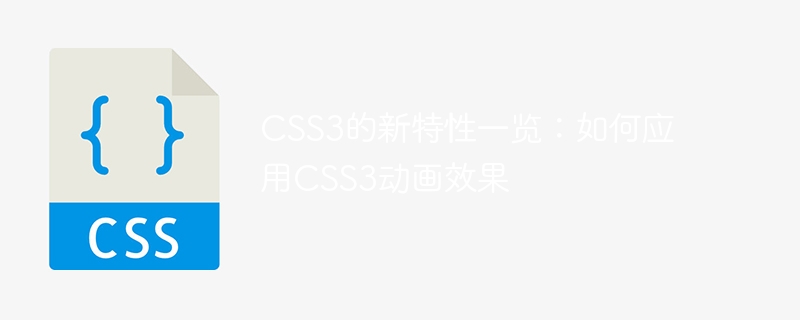

Overview of the new features of CSS3: How to apply CSS3 animation effects
Introduction:
With the development of the Internet, CSS3 has gradually replaced CSS2 as the most popular front-end development tool. Commonly used style languages. CSS3 provides many new features, the most popular of which is animation effects. By using CSS3 animation, you can add stunning interactive effects to web pages and improve user experience. This article will introduce some commonly used animation features of CSS3 and provide relevant code examples.
1. Transition Animation
Transition animation is the simplest and most commonly used animation effect in CSS3. By setting the transition attribute of an element, you can achieve a smooth transition of the element from one state to another within a certain period of time, such as changes in color, size, or position.
Here is an example that demonstrates the color of a button transitioning to another color when the mouse is hovered:
<button class="transition-btn">按钮</button>
.transition-btn {
color: white;
background-color: blue;
padding: 10px;
border: none;
transition: background-color 0.5s;
}
.transition-btn:hover {
background-color: red;
}In the above example, when the mouse is hovered over the button, the background The color will smoothly transition from blue to red with a transition time of 0.5 seconds.
2. Keyframe Animation
Keyframe animation is a relatively advanced animation effect in CSS3. In keyframe animation, you can define the attribute values of elements at different points in time. This allows for more complex animation effects. Keyframe animation usually contains @keyframes rules and animation attributes.
The following is an example that demonstrates the animation effect of a picture moving from left to right:
<img class="keyframe-img lazy" src="/static/imghw/default1.png" data-src="image.jpg" alt="An overview of the new features of CSS3: How to apply CSS3 animation effects" >
.keyframe-img {
position: relative;
animation: slide 3s linear infinite;
}
@keyframes slide {
0% { left: 0; }
100% { left: 200px; }
}In this example, the picture will move smoothly from the left to the right, and finally reach the end. After going to the right, return to the far left. The total time of the animation is 3 seconds, using a linear change speed and playing in an infinite loop.
3. Transform Animation
Transform animation uses the transformation attribute (transform) of CSS3 to achieve the deformation effect of elements, such as rotation, scaling, movement, etc. By setting different deformation properties and values, you can create a variety of unique animation effects.
The following is an example that demonstrates the effect of a block rotation:
<div class="transform-box"></div>
.transform-box {
width: 100px;
height: 100px;
background-color: green;
transform-origin: center center; /* 变形基点为中心 */
animation: rotate 5s linear infinite;
}
@keyframes rotate {
0% { transform: rotate(0deg); }
100% { transform: rotate(360deg); }
}In the above example, the block will rotate around its center point at a rate of one revolution per second. The total time of the animation is 5 seconds, using a linear change speed and playing in an infinite loop.
Summary:
The animation features of CSS3 provide a rich variety of animation effects. By using transition animation, keyframe animation and transformation animation, front-end developers can add vivid and attractive interactive effects to web pages. The above examples are just the tip of the iceberg of CSS3 animations. I hope that the introduction in this article can provide readers with some inspiration to create more cool animation effects. Let us create unlimited imagination and creativity in the online world together!
The above is the detailed content of An overview of the new features of CSS3: How to apply CSS3 animation effects. For more information, please follow other related articles on the PHP Chinese website!




